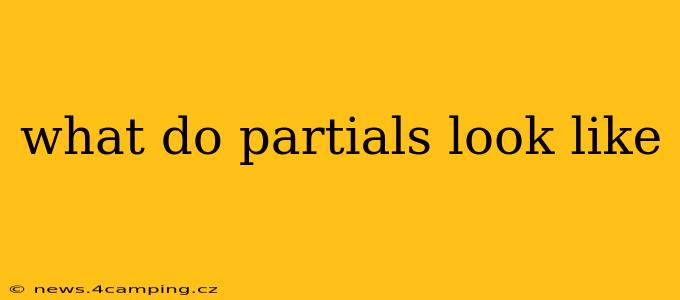What Do Partials Look Like? A Deep Dive into Partial Views
The term "partials" usually refers to partial views in the context of web development frameworks like Ruby on Rails, Django (Python), and others. They aren't a universal programming concept like, say, functions or classes, but rather a powerful tool for code reuse and improving the organization of your web applications. Essentially, they are reusable chunks of HTML, often combined with server-side code, that are included within larger views.
This means they don't "look like" anything on their own in the sense of a visually rendered webpage. Instead, they define the structure and content of a section that will be part of a complete page. Their appearance depends entirely on how they're used and what data is passed to them.
Let's break down what this means and address some common questions:
What are the benefits of using partials?
Partials offer several key advantages:
-
Code Reusability: Avoid redundant code. Instead of repeating the same HTML snippets across multiple pages (e.g., a navigation bar, a footer, a sidebar), you create it once in a partial and include it wherever needed. This reduces development time and maintenance overhead.
-
Improved Organization: Partials keep your views cleaner and more manageable. By breaking down large views into smaller, self-contained components, you improve readability and make it easier to understand and maintain your codebase.
-
Easier Maintenance: If you need to update a common element (like a logo or copyright notice), you only need to change it in one place—the partial itself—rather than hunting down every instance across your website.
-
Simplified Templating: Partials contribute to more effective templating. You can create a modular design where different parts of the layout are managed independently, allowing for easier customization and updates.
How do partials differ from templates or components?
The line between partials, templates, and components (especially in frameworks like React or Vue.js) can blur. However, some key distinctions exist:
-
Partials (typically in server-side frameworks): Primarily HTML snippets rendered on the server before being sent to the client's browser. They often contain server-side code interwoven with HTML.
-
Templates (often more generic): A broader term referring to the structure or framework for generating dynamic content. Partials can be part of a larger template.
-
Components (often in client-side frameworks): Self-contained, reusable pieces of UI that manage their own state and data. They handle rendering and logic on the client-side, typically using JavaScript. Though the concept is similar to partials in terms of reuse, their implementation and behavior differ significantly.
Where are partials typically stored in a project?
The location of partials varies depending on the framework you're using. However, they're usually kept in a dedicated folder within the project's views directory. Commonly used names for this folder include: _partials, partials, components (though the latter can also be used for client-side components).
What do partials look like in different frameworks? (Examples)
The syntax for defining and using partials differs between frameworks. However, the underlying concept remains the same: a reusable chunk of view code. Examples would be too lengthy to include here, but a quick search for "[Framework Name] partial views" (e.g., "Rails partial views," "Django template inheritance") will yield plenty of tutorials and examples.
Can partials contain logic?
Yes, many frameworks allow you to embed server-side logic (e.g., loops, conditional statements) within partials. This enables dynamic content generation within the reusable sections. However, it's crucial to balance this with the principle of separation of concerns—overly complex logic in a partial can make it harder to maintain.
In short, a partial isn't something you see directly. It's a building block that forms part of a larger web page, offering a highly effective way to create efficient and maintainable web applications. Understanding how partials function within your chosen framework is vital for any web developer.
